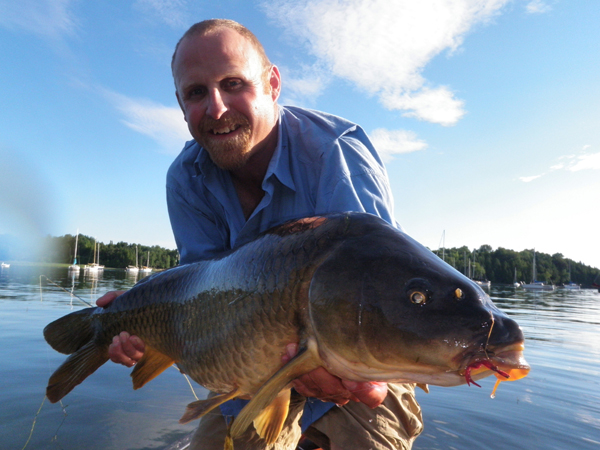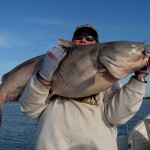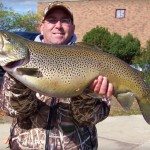Carp have quickly become a sensation in the fly fishing world. They are extremely challenging fish requiring stealth, precision and patience, they run far when hooked, get to large sizes and are found almost everywhere. Many compare it to fly fishing for bonefish on the saltwater flats and the similarities are striking between the two fish. So how do you get started chasing golden bones?
Fly Rods
These fish are large and powerful but also require a bit of delicacy when the fly line is landing. 6 to 8 weight rods are the norm with the majority of people opting for a 6. These rods will give you plenty of backbone when you get into a 20 pound fish but will also keep the line from smacking down on the water too hard.
A medium to medium fast action rod is perfect for this purpose. A very fast action rod can be counter-productive because it doesn’t provide quite as much flex to protect lighter tippets. If you don’t have one already, consider a large arbor reel. These reels have a better capacity for backing and will pick up your line much faster. This will help you when the carp takes off.
Fly Lines
Line color can be a factor. Bright colored lines have a tendency to spook carp. Think of carp like trout on steroids. They are very nervous fish and have a very sensitive lateral line. Choose a line that is muted in color and that will help out. A bonefish leader is a good bet for chasing carp but an appropriate trout leader will do as well. It does pay off to add a couple of feet of tippet to the end of your leader, especially in clear water.
The more distance between your fly and line the better. You won’t need much tippet- a spool of 8 lb will work very well. Fluorocarbon tippet is an excellent choice because it is tough and disappears in the water.

Carp Diet and Fly Selections
Carp have a highly varied diet. They will eat almost anything available to them including (but not limited to) vegetation, worms, snails, insects, crustaceans, terrestrial insects, berries and smaller fish. It is amazing to consider that such large fish will eat such small food. How is it possible for a 30 pound fish to eat midge larvae? The answer is volume. Carp eat a lot and they browse continuously. As an angler you can take full advantage of that fact.
For the fly tying angler the diversity of a carp’s diet means a bonanza of imitations to tie up. There are a number of flies that a carp box should not be without though. Crawfish are a high priority so have several patterns in sizes 4 through 10 in rust, olive and brown.
A good selection of nymphs including the Beadhead Prince (8-14), Caddis Larvae in green and tan (10-14), Gold Ribbed Hare’s Ear (8-14) in natural, rust and olive with and without beads, and Dave Whitlock’s Rubber Legged Red Fox Squirrel Nymph (6-12) in olive, rust and natural. Another deadly nymph is the Clouser Swimming nymph (4-10) in rust, tan and olive. If you are fishing streams be sure to include a stonefly pattern. Worm flies are a must so be sure to have San Juan Worms (8-14) and the Eggi-Juan-Kenobi (10-14) in red, pink and tan handy as well. If the body of water you are fishing has Hexegenia mayflies be sure to have some imitations of the nymphs with you as well.

A very important consideration with flies is weight. Carp feed at different levels so to be successful fly fishing for them you have to be ready to put they fly where they are feeding. Weighted flies should be in three categories- unweighted, medium weight and depth charge. It is not unusual to find carp near the surface which is where the unweighted flies will come into play. To get carp in water up to 2 or 3 feet in depth a medium weight is in order but if they are deeper than that you want something that is going to drop like a rock. Lead eyes or tungsten beads can really be very helpful to get flies down. Heavily weighted crawfish patterns are a good way to get a carp’s attention- they will kick up little puffs of mud as you retrieve them.
Carp Behavior
Carp behavior is a very important factor in getting one on the end of your line. If you spend your time making observations before you fish you will catch more carp than if you just start blind casting. Carp fishing is a very visual game which is one of the reasons it is so exciting. Take full advantage of that and watch what they are doing. If the carp are splashing around in weedy shallows, especially in the spring time, your odds are not good. Those fish are spawning and won’t eat. Don’t bother casting at groups of fish that are moving fast- they have somewhere to go and won’t be interested. Lazy carp sitting motionless near the surface of the water give you a 50/50 chance- often an unweighted worm pattern put gently in front of them will get their attention.

What you really want to look for is actively feeding fish. Carp will mud or tail just like a bonefish or redfish. Look for fresh mud coming up from the bottom and put your fly in the middle of it. A crawfish pattern works great in this situation. Pods of slowly moving fish are another excellent choice. Look for their mouths to be opening and closing which will indicate that they are feeding. These fish will give you a great shot at hooking up.
There can be opportunities to catch carp on the surface too. When mulberries are ripe along rivers carp seem to relish the chance to eat them. A purple berry fly or just simply some purple chenille or yarn on a hook will make a decent representation of the berry and look for those rubbery lips near the top of the water. Time it right and you will get your fish. Carp will also look up if there is a good insect hatch. Here you should do your best to imitate the flies on the water. Another time that carp will slurp down flies from the top is when there are a lot of seeds from dandelions or cottonwoods available. Simple white hackled patterns will serve you well in this situation.
Casting and Catching
Accurate casting makes a huge difference in the quest for carp. A feeding carp’s vision is fairly limited. A fly needs to be in a fairly small window- you want to put the fly in a basketball sized area around their head. This is where good casting and strategy pays off. If a carp is feeding on the bottom in water four feet deep an angler will have to put the fly out in front of it with enough time for the fly to get deep. Leading the fish you are targeting is critical. Also remember that unless carp are feeding on something on the surface they generally don’t look up. Most of their food resources are on or near the bottom. Put the fly down near the fish’s mouth for best results.


Once a carp is hooked the fun begins! Carp are definitely a fish that fights like crazy. Carp in open water will take right off and run like a bonefish. They will make a good run or two before giving up. Sometimes they will also bulldog deep. If there are weeds present don’t be surprised if the carp digs right into them. This is where your patience can be tested, but if you take your time you can pull a good sized carp out of heavy weeds. A big net makes landing a carp much easier. Rubber nets will cause less damage to the fish as well.
Final Tips
Unless the fish are in small to mid-sized rivers or are on a relatively shallow hard bottomed area of a lake or pond where you can wade easily, one of the best ways to fly fish for carp is by boat. Canoes and kayaks are excellent ways to access carp water but motorized boats can work as well. A caution for using a boat- if you have an older motor that dumps a lot of gas or oil you won’t catch many carp. The smell of the petroleum products will put the fish down and they won’t come back. Similarly, loud boats make it harder to catch carp. Aluminum and metal boats that bang around a lot will spook fish too. Some indoor/outdoor carpet on the bottom of the boats will make a big difference in this situation.

Spring time provides a few opportunities for carp. The fish tend to be a bit sluggish and don’t feed as heavily as they will later in the year. Once the water hits the 50’s this changes. They start putting on the feed bags but then something happens that will prevent a lot of carp from being caught. The spawn tends to happen sometime in May or June. During this time it is not unusual to see very large congregations of carp in the shallows splashing around. The water will be very muddy and the fish will be very active. It is not likely that many fish will be caught though. Shortly after the spawn the fish will be much more receptive.
Hot summer days are a great time to target these fish. Carp will remain active all summer. They are also able to handle higher temperatures and lower oxygen environments very well. When it is too hot to target trout, carp are an excellent option. Carp are safe to fish for even when water temps get up into the upper 80’s. Fly fishing for golden bones remains excellent until water temps start dropping below 50 degrees.
If you are up for a challenge try out carp on a fly. They are widely available in most areas, get to large sizes, will test your skills, and are a lot of fun. If you are able to put aside the “trash fish” image that they have had you will find that you have a new worthy adversary to consider. One last thing to keep in mind with carp- their musculature and physiology allows them to swim twice as far and fast as similar sized trout or bass. Just try to find a place where trout or bass routinely get over 20 pounds….
Drew grew up in Northern New York where he received his first fly rod as a college graduation present. He cut his teeth on trout, salmon and bass out of Lake Champlain tributaries but soon realized that there was a lot more to catch with flies. A true fish geek, Drew has worked at a public aquarium and routinely spews fish Latin names despite being deathly allergic to eating his finny friends. He is a science teacher for the school year and spends his summers guiding for warm water fish in the Green Mountain State. Visit Drew’s website at www.drewpriceonthefly.com/






